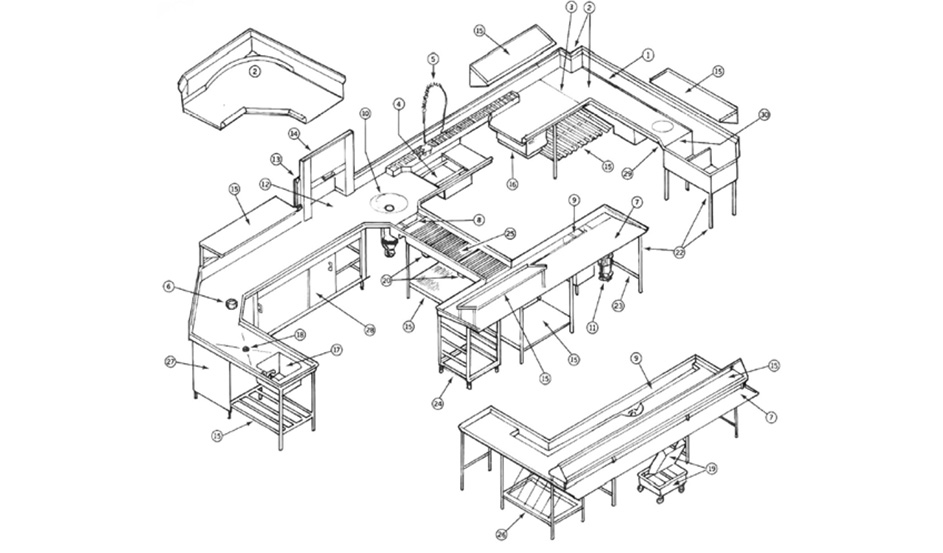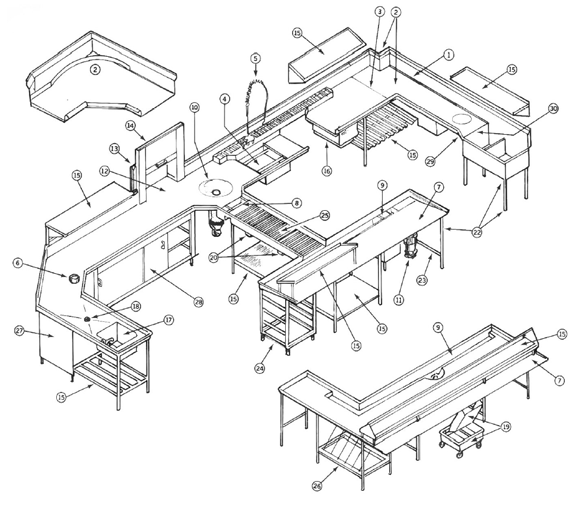
COMMERCIAL KITCHEN DESIGN TIPS
Whatever the style of kitchen, the general rule is that the larger the operation, the more services and facets have to be considered.
The three prime considerations that dictate kitchen design are:
- Service requirement: Consider the service the kitchen has to provide – for instance, the numbers being served, is it an la carte menu, plated service, self-service, cafeteria-style, etc?
- Space available: Is the space allocated sufficient to fit in the equipment required?
- Budget: Always have an accurate idea of spend available.

The design process should never progress without a clear understanding of these considerations, which should then be structured around the need to provide the required service, while satisfying the basic codes of practice of food hygiene and handling and complying with statutory legislation.
Always carry out a risk assessment of any design to identify any shortfalls – for instance, the need to keep the food preparation area separate from the rest of the kitchen to negate the risk of cross-contamination.
Any design should incorporate good workflow patterns and ergonomic solutions to building constraints, so the following criteria should be considered:
Delivery
- Ensure goods vehicles have adequate access to the premises, providing direct deliveries to the catering area. Provide adequate space to allow a goods check-in area before entering the kitchen.
- Where possible, bulk storage should be close to the goods-in area so there’s no need for delivery personnel to enter the kitchen and food preparation area. Never underestimate the need to allow adequate space for dry, chilled and frozen goods. Many suppliers have minimum drop requirements.
Preparation
- Position main preparation between bulk storage and the cooking process, to ensure the correct flow pattern. Where possible, different processes should be segregated – ie, raw meat and fish separate from prepared foods. If necessary, consider chilled preparation areas for high-risk food environments. In smaller establishments where segregation is not possible, stringent regimes must be employed to ensure segregation of processes, so that utensils and tables are suitably sanitised between processes. In addition, consider adequate refrigerated storage for prepared food.
- Provide adequate prep sinks, separate pot-wash sinks and hand-wash facilities.
Cooking
- When selecting cooking equipment, consider the requirements of the menu and the ability of the staff using the equipment. Although state-of-the-art equipment such as programmable combi-ovens, pressure bratt pans and computerised deep-fat fryers may be nice to have, they may not always be appropriate for the style and content of some menus. Conversely, never underestimate the benefits that hi-tech equipment can provide, in terms of cost control, and energy and labour savings.
- Workflows and safety should be the prime drivers in the layout of a professional kitchen. Simple things include ensuring there’s a set-down space next to deep-fat fryers, never siting a fryer at the end of a run, and always allowing a minimum of 900mm corridor to the front of any cooking equipment, although 1,200mm is ideal.
- Ensure the flow of the cooking suite suits the style of service, with fast-cook equipment such as fryers, salamanders and griddles nearest to the point of service and bulk cooking kit such as bratt pans, convection ovens and boiling pans further away.
- Consideration should also be given to the mechanical and electrical services available. Sometimes it’s not possible to get gas into a building, or you may be restricted by the size of the incoming electrical supply.
Food Service Area
- The space requirement for service is often underestimated, particularly by architects. Whether the operation is waited service or tray-line style, you can minimise queuing by the provision of multi pick-up and service points. Consider adequate space for hot and cold holding of prepared food ready for service. If it’s a large site, counters may need to be replenished several times during a service period. In an la carte restaurant, allow sufficient space for plating up and hot pass. Where possible, locate the service point close to the final cooking process to avoid double handling.
Wash-up
- Nearly always undersized by space planners, the dishwashing operation is key to the success of any catering establishment. If it fails through inefficient planning, the restaurant cannot function. To determine the space required, the capacity of dishwasher and the amount of ancillary sorting space, calculate the number of crockery, cutlery and hollow-ware items (don’t forget trays) to be used during a service period. All reputable dishwasher manufacturers can help you with this calculation and provide you with the correct size system and machine. Remember to allow sufficient space for the storage of clean items and the disposal of rubbish, ensuring the two are segregated to avoid cross-contamination.
- Location is paramount to the efficient management of the space. Ideally it should be close to both the restaurant and service area to avoid double handling.
- The amount of steam and moist air produced is often underestimated. If possible, consult a ventilation engineer.
Refuse
- Always allow for a clearly defined route for dirty dishes that won’t conflict with preparation and service areas. Consider the location of an outside refuse bay, well away from the kitchen entrance.
Staff facilities - Ensure that appropriately located and sized facilities for staff changing and locker areas and staff toilets are available near the kitchen.
Environmental
- Consider energy efficiency of all equipment, as fuel costs are now higher than ever. Also, consider volumes of water used and research your product; many major manufacturers use energy efficiency as their USPs.
- Consider any “green” policies, allow for recycling of bottles, aluminium, plastic and paper. If possible, have a recycling area.
- Ensure correct ventilation and air replacement are available in all areas. Consult an engineer to ensure you comply with the minimum requirements of the local authority’s clean air policy.
- Ensure lighting provides at least the minimum requirement of 500 lux at worktop height.
- Invite your local EHO to view your plans and pass comment. It’s always best to get them on your side at the outset.
Building fabric
- Ensure floors (non-slip), walls and ceilings can be cleaned and maintained easily.
And remember, almost all designs are a compromise. A good design is one that best suits the constraint of space and budget without detrimental effect on service.
Derek White is managing director of catering design consultancy Food Service Consultants (www.foodserviceconsultants.co.uk) and a member of the Foodservice Consultants Society International

